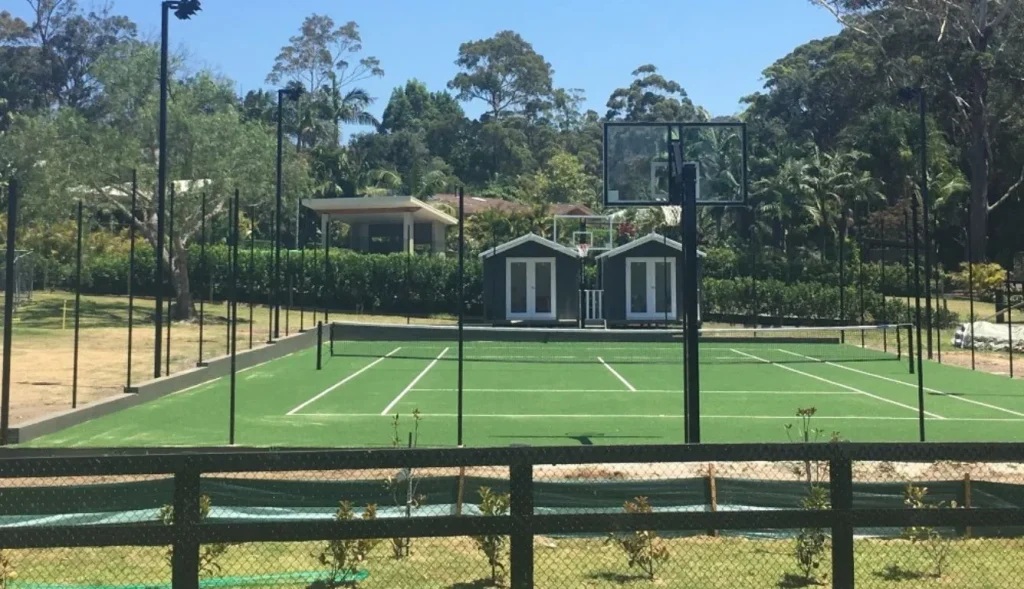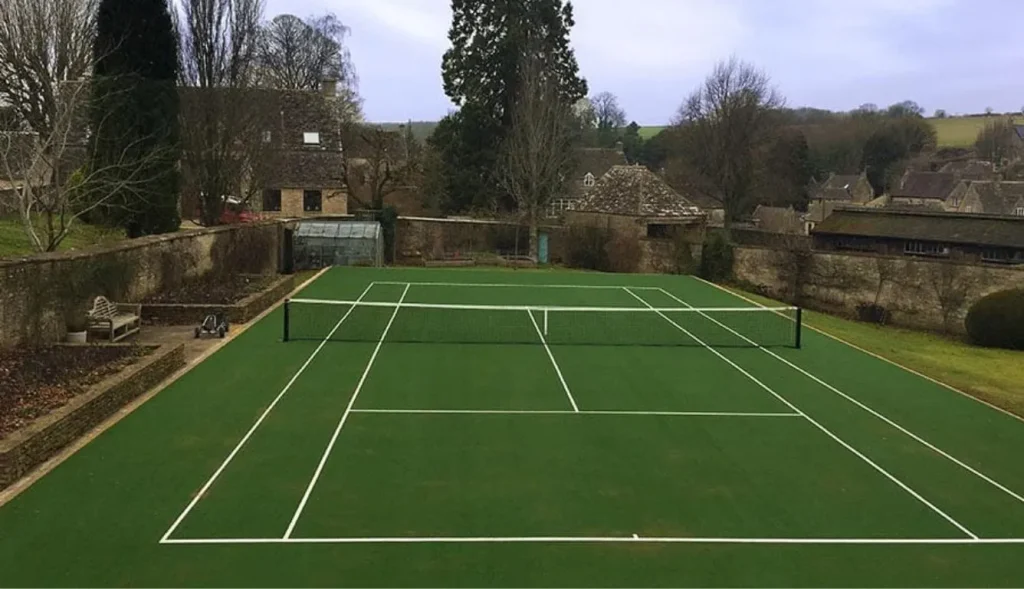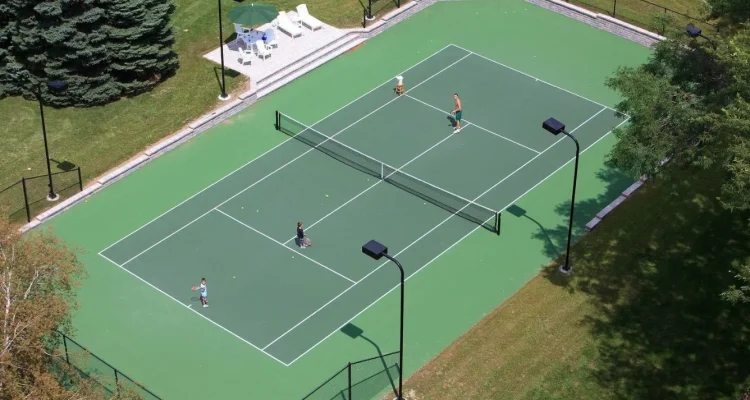Introduction
Building a tennis court is an exciting project that can add significant value to your property and provide endless hours of entertainment and exercise. Whether you’re a tennis enthusiast or just looking to improve your backyard, constructing a tennis court is a big but rewarding undertaking. This guide will walk you through the entire process, from planning and design to construction and maintenance, ensuring you create a high-quality court that meets your needs.

Understanding the Basics
Types of Tennis Courts
The first step in building a tennis court is deciding on the type of court you want. The three main types of tennis courts are grass, clay, and hard courts. Each surface has its own set of advantages and challenges:
- Grass Courts: Known for their fast gameplay and softer surface, grass courts require significant maintenance and are best suited for regions with consistent moisture.
- Clay Courts: Clay surfaces offer slower gameplay and are easier on the joints. They require regular maintenance to keep the surface smooth and playable.
- Hard Courts: Made from materials like asphalt or concrete, hard courts are durable, low-maintenance, and offer a consistent bounce, making them the most common choice for many players.
Choosing the Right Location
Selecting the right location for your tennis court is crucial. You’ll need a flat area with good drainage, away from large trees that could drop leaves or roots that could damage the surface. Consider the court’s orientation as well; ideally, the court should run north-south to minimize the impact of the sun on players’ vision.
Legal Requirements and Permits
Before you begin construction, check with your local authorities to ensure you comply with all zoning laws, building codes, and permit requirements. Some areas may have restrictions on court size, lighting, and fencing, so it’s essential to get approval before moving forward.
Designing Your Tennis Court
Selecting the Surface Material
Once you’ve decided on the type of court, it’s time to select the surface material. The surface you choose will affect the court’s playability, maintenance, and longevity. Consider factors like your playing style, climate, and budget when making your decision.
Determining Court Dimensions
A standard tennis court measures 78 feet in length and 36 feet in width for doubles play, with a smaller 27-foot width for singles. You’ll also need to account for additional space around the court for fencing, benches, and other amenities. Ensure the dimensions you choose meet your specific needs and adhere to any regulations.
Orientation and Layout Considerations
The court’s orientation is another critical aspect of the design. As mentioned earlier, a north-south orientation is ideal for minimizing sun interference. Additionally, consider wind direction, surrounding structures, and accessibility when planning your layout.
Site Preparation
Clearing and Leveling the Ground
Before construction begins, the site must be thoroughly prepared. Start by clearing any vegetation, rocks, and debris from the area. If the ground is uneven, you’ll need to grade it to create a level surface. Proper drainage is also essential to prevent water from pooling on the court, so consider adding drainage channels or slopes.
Setting Up the Foundation
The foundation is the most critical part of your tennis court, as it supports the entire structure. Begin by laying a sub-base of crushed stone or gravel to provide stability and drainage. Compact the base material using a roller to create a solid, even surface. If necessary, install drainage pipes beneath the court to manage water runoff effectively.
Construction Process
Building the Court Surface
With the foundation in place, it’s time to build the court surface. For hard courts, start by laying an asphalt or concrete layer, ensuring it’s smooth and level. If you’re constructing a clay or grass court, follow the specific installation process for those materials. Once the surface is complete, apply the final layer of your chosen material, such as acrylic for hard courts or finely crushed stone for clay courts.
Painting Lines and Markings
After the surface has cured, it’s time to paint the lines and markings. Use high-quality, weather-resistant paint to ensure the lines remain visible and durable. Measure carefully to ensure accuracy, and consider hiring a professional to assist with this step if needed.
Installing Fencing and Lighting
To complete your tennis court, you’ll need to install fencing around the perimeter to keep the ball in play and enhance security. Chain-link fencing is a popular choice for its durability and affordability. If you plan to play at night, adding lighting is essential. Install tall, strategically placed lights that provide even illumination across the court without causing glare.
Final Touches
Landscaping Around the Court
Landscaping can enhance the overall appearance of your tennis court and make it more enjoyable to use. Consider planting trees or shrubs around the perimeter for privacy and shade. Additionally, you can create pathways, seating areas, and even a small garden to make the court a welcoming space for players and spectators alike.
Maintenance and Care
Once your tennis court is complete, regular maintenance is key to keeping it in top condition. Hard courts should be cleaned and inspected regularly for cracks, while clay courts require frequent watering and rolling. Grass courts need to be mowed and treated for weeds. Additionally, seasonal care, such as winterizing the court, will extend its lifespan and ensure it remains playable year-round.
Frequently Asked Questions
What is the average cost of building a tennis court?
The cost of building a tennis court can vary widely depending on factors like location, materials, and labor. On average, you can expect to spend between $25,000 and $100,000.
How long does it take to build a tennis court?
The construction of a tennis court typically takes 4 to 8 weeks, depending on weather conditions and the complexity of the project.
What are the best materials for a tennis court?
The best material depends on your preferences and climate. Hard courts (asphalt or concrete) are durable and low-maintenance, clay courts offer excellent playability, and grass courts provide a traditional, fast-paced game.
Can I build a tennis court in my backyard?
Yes, as long as you have enough space and comply with local zoning laws and regulations, you can build a tennis court in your backyard.
How do I maintain a tennis court?
Regular maintenance includes cleaning the surface, repairing cracks, and ensuring proper drainage. Specific care varies depending on the court type, such as watering and rolling for clay courts or mowing for grass courts.

Conclusion
Building a tennis court is a significant investment, but with careful planning and execution, you can create a space that provides years of enjoyment and increases the value of your property. From choosing the right location and materials to ensuring proper maintenance, every step is crucial to the court’s success. Now that you have the knowledge and tools, it’s time to start your tennis court project. Happy playing!


Congratulation!